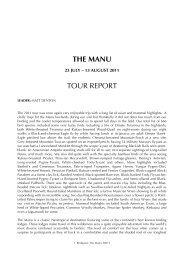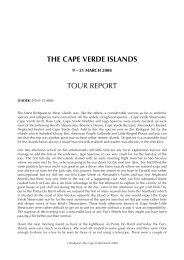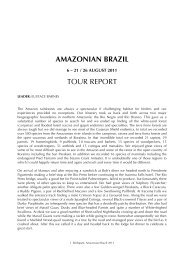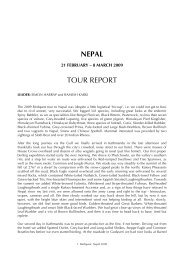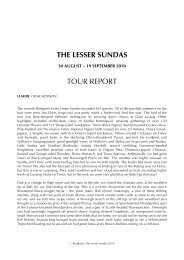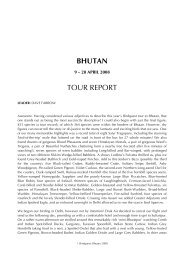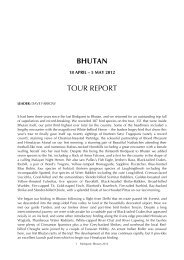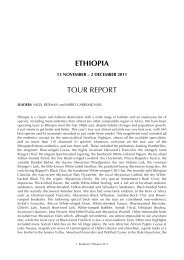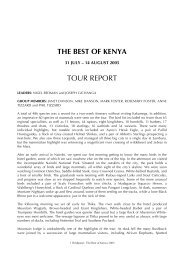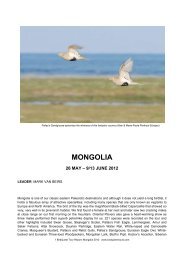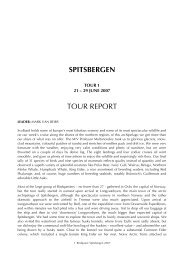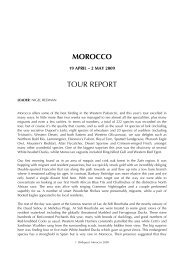INDONESIA (REMOTE EASTERN) REP 10 - Birdquest
INDONESIA (REMOTE EASTERN) REP 10 - Birdquest
INDONESIA (REMOTE EASTERN) REP 10 - Birdquest
Create successful ePaper yourself
Turn your PDF publications into a flip-book with our unique Google optimized e-Paper software.
Initially though, a tyre needed to be replaced, so while this was being done we birded the first patch<br />
of secondary scrub and plantation that we came to. Almost immediately we heard the familiar tones<br />
of a white-eye, and there was Kai Besar's most well-known endemic, the Great Kai White-eye. They<br />
proved to be common enough during the morning. Our first Kai Coucal also perched-up in the open<br />
to be scoped. The less well-known endemic on this island is Kai Leaf-warbler, a very distinctive<br />
species that was trashed in the Island Leaf-warbler ‘dustbin’. To see this we needed to head for the<br />
hills and attain some elevation. Driving to the highest point of the little road we followed a side-track<br />
down to Bukit Indah Mission, with a backdrop of beautifully forested hills. Provided with a local<br />
guide, we asked to be taken along a trail that would get us higher up towards the peaks. Some<br />
misunderstanding followed and we traipsed along a muddy path that seemed to go nowhere.<br />
Eventually we cleared things up, and after consulting with some locals in a little hut, we found our<br />
way up to 425m, though by that time we were very hot and sweating profusely! Soon though, we<br />
heard a leaf-warbler singing and worked our way into a clearing where we could get a better view.<br />
Excellent; we had very nice looks at a pair feeding dependant fledged young – job done. The trail<br />
back down to the mission was quick and easy, so we were puzzled as to exactly what had gone<br />
wrong in the first place! Other good species here were the local race of Variable Goshawk, a pair of<br />
the endemic form of White-bellied Cuckoo-shrike, and perched-up Brush Cuckoo. After lunch back<br />
at the jetty we returned to Kai Kecil and then drove to a patch of secondary forest on neighbouring<br />
Kai Dullah, which is accessed by a bridge. Here we were hoping to find the soon-to-be-split Kai<br />
Boobook. Unfortunately there was not a peep, and the habitat had apparently also deteriorated<br />
considerably since it was last seen here, according to Ceisar. Our last day on the Kai Islands was<br />
spent exploring new forest patches on Kai Kecil. The first, at Letfuan, was rather poor but we did get<br />
great perched views of a Blue-breasted Pitta, and some feral Tanimbar Corellas were unexpected.<br />
The second site turned out to be really good, an area of logged forest at Samawi. Walking up and<br />
down a several kilometre-long stretch for much of the day, we notched-up some really good birds.<br />
Yellow-capped Pygmy-parrots were found to be quite common and we had some great views, a large<br />
breeding group of Eclectus Parrots were watched for a long time, we saw several Red-flanked<br />
Lorikeets in flight, Pied Bronze Cuckoo, Kai Coucal, another dark form of Wallacean Cuckoo-shrike<br />
(related to the one on Tanimbar) and, not long before dark, we finally caught up with the scarce<br />
Green Figbird in a giant fig tree (several had earlier been seen more fleetingly). After dark, there was<br />
still no boobook though, so we decided to try Letfuan again, as this had at least looked good for<br />
owls. On arrival and immediately after playing the sound, a bird called back loudly, but then<br />
promptly shut up. We waited around and tried, but clearly we were out of luck and time with this<br />
one.<br />
From Kai it was another short flight back to Ambon using a third airline and a third aircraft type.<br />
Then a quick drive across the northern part of the island to meet the very swish Seram ferry, with its<br />
air-conditioned lounge fitted-out with old business-class aircraft seats. A short trip ‘up top’ revealed<br />
almost no birds over the sea apart from a Brown Booby, and so we made the most of the luxury until<br />
we arrived at Masohi on the south coast of Seram. After checking into the hotel we visited some<br />
lowland forest patches nearby. Rain-stopped-play again however, and by the time it had finished it<br />
was getting late. A flock of 13 Great-billed Parrots was unusual and we saw Lazuli Kingfisher again.<br />
We spent the following week on Seram, based at a well-situated coastal guest house at Sawai, on the<br />
north coast. Built on stilts like a pier, it was surrounded by some impressive coral-growth with its<br />
attendant rich variety of colourful fish. The small village of Sawai is tucked into a sort of cove, and is<br />
situated 30 minutes down a largely rough track. Our three Toyota Kuangs mostly made light work of<br />
this, though one of the drivers was a ‘rookie’ and bored himself into a deep mud-hole on one<br />
afternoon. We saw most of the bird specialities on the first full day, when we drove over from<br />
Masohi, and it became a case of ‘the law of diminishing returns’, as we birded various levels of the<br />
6 <strong>Birdquest</strong>: Remote Eastern Indonesia 20<strong>10</strong>




